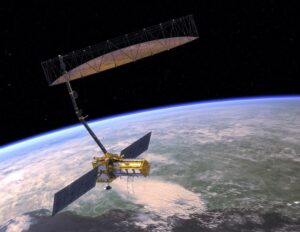“NASA’s Earth System Observatory will be a new architecture of advanced spaceborne Earth observation systems, providing the world with an unprecedented understanding of the critical interactions between Earth’s atmosphere, land, ocean, and ice processes,” the White House said of the new program. “These processes determine how the changing climate will play out at regional and local levels, on near and long-term time scales.”
NASA, in a separate statement, said the Earth System Observatory will be a set of missions addressing the “designated observables,” a set of key observations that scientists recommended the agency pursue in the Earth science decadal survey published in early 2018.
Those designated observables include studies of aerosols; clouds, convection and precipitation; mass change in snow, ice and water; surface biology and geology; and surface deformation and change. The decadal survey did not recommend specific mission concepts to address those topics, but did estimate a range of costs for each mission, from $300 million to $800 million.
“Over the past three decades, much of what we’ve learned about the Earth’s changing climate is built on NASA satellite observations and research,” NASA Administrator Bill Nelson said in the agency statement. “NASA’s new Earth System Observatory will expand that work, providing the world with an unprecedented understanding of our Earth’s climate system, arming us with next-generation data critical to mitigating climate change, and protecting our communities in the face of natural disasters.”
The announcement did not offer any budgets or schedules for the Earth System Observatory program. In recent months, though, NASA officials said several of the designated observables were nearing the “pre-Phase A” level of development to perform mission concept studies.
Karen St. Germain, director of NASA’s Earth science division, hinted about the Earth System Observatory concept at a March meeting of a National Academies committee. “I don’t view this as a menu of systems you can select from. I view this as an integrated observatory, where we are looking at all the major ‘muscle movements’ of the Earth system,” she said, comparing it to NASA’s Earth Observing System program three decades ago.
The Earth System Observatory will presumably be included in NASA’s fiscal year 2022 budget proposal, which includes a $250 million increase above the $2 billion appropriated for fiscal year 2021. A budget outline released April 9 said the Earth science funding would “initiate the next generation of Earth-observing satellites to study pressing climate science questions.” A complete fiscal year 2022 budget proposal is scheduled for release May 28.
That increase has already attracted criticism from some in Congress. In a May 21 letter to Nelson, Reps. Frank Lucas (R-Okla.) and Brian Babin (R-Texas) questioned that increase after NASA announced it would delay the next New Frontiers planetary science mission competition two years, citing “other missions being in peak development and COVID-related challenges.”
Lucas and Babin, the ranking members of the House Science Committee and its space subcommittee respectively, wrote they were concerned about a “significant reprioritization” in NASA’s science programs. “Delays and cuts to planetary science exploration could have particularly dire impacts on U.S. leadership in space as China seeks to expand its planetary science program, pursue international partnerships to expand its influence, and justify the Communist Party’s control over the Chinese people through scientific accomplishments,” they argued.
NASA also disclosed in the statement that a mission already in development with the Indian space agency ISRO, the NASA-ISRO Synthetic Aperture Radar (NISAR) spacecraft, will be considered a pathfinder for the Earth System Observatory. NISAR, scheduled for launch next year, will carry two radar systems to measure changes in the Earth’s surface, one of the designated observables from the Earth science decadal.



